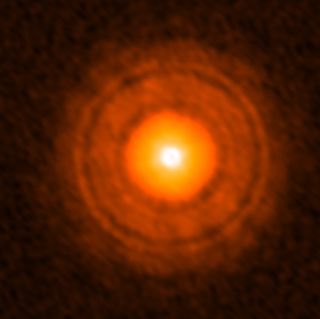A Nearby Star Is Birthing a Massive Icy World

TW Hydrae is something of a celebrity in protoplanetary circles. The 10 million year old star is thought to resemble our sun when it was young and, as observational techniques have improved, astronomers have been mesmerized by the star's protoplanetary disk, which contains several rings that could be indicative of baby planets being born.
Previous research has shown that there's likely a small exoplanet being born very close to the star, leading to speculation that it could be the birth place of an Earth-like exoplanet.
RELATED: 'Baby Earth 2.0' Found in Young Star's Crib
Now, astronomers using data from the Atacama Large Millimeter/submillimeter Array (ALMA), located high in the Atacama Desert in Chile, have added another layer of evidence that the prominent outer ring may well contain an "ice giant" exoplanet in the earliest stages of birth.
WATCH VIDEO: Exo-Uranus Found!
ALMA, which is an interferometer consisting of 66 radio antennae, can peer into the TW Hydrae system with astounding precision. During its studies of the star's dusty protoplanetary disk astronomers have been able to use it as a kind of protoplanetary "petri dish" owing to its close proximity to Earth (at a distance of only 175 light-years) and its fortuitous alignment. The disk is almost perfectly facing us, allowing astronomers to study planetary birth in action.
By studying two different wavelengths of radio emissions from the warm dust in the TW Hydrae disk, different sizes of dust particles can be studied. According to theoretical models of the protoplanetary disk, the dark rings embedded inside the bright disk should contain smaller dust particles than the rest of the disk if a baby exoplanet is present.
Get the Space.com Newsletter
Breaking space news, the latest updates on rocket launches, skywatching events and more!
RELATED: Snow's Up! Frosted Star System Discovered
Sure enough, in research carried out by Takashi Tsukagoshi and his team at Ibaraki University, Japan, the most prominent gap, located at around 22 AU (22 times the Earth-sun distance) contains few large particles and is filled with smaller dust particles.

According to their models, should a planet be forming inside this dark ring, frictional processes are causing larger dust particles to be forced out of the ring as the baby exoplanet orbits the star. Smaller dust particles, however, remain unaffected and will preferentially fill the dark ring.
With this information, the researchers have been able to calculate the mass and probable composition of the planet. By their reckoning, this sun-like star is in the process of forming a baby ice giant exoplanet, much like the solar system's Uranus or Neptune.
RELATED: Dust Gaps Around Young Stars Not 'Proof' of Exoplanets
"Combined with the orbit size and the brightness of TW Hydrae, the planet would be an icy giant planet," said Tsukagoshi.
By studying this very young star system, astronomers don't only have a ringside seat of the complexities of planetary formation, they are looking back in time when our sun was a youngster and how some of the biggest planets in our solar system likely formed. Fascinating.
Originally published on Discovery News.
Join our Space Forums to keep talking space on the latest missions, night sky and more! And if you have a news tip, correction or comment, let us know at: community@space.com.
Ian O'Neill is a media relations specialist at NASA's Jet Propulsion Laboratory (JPL) in Southern California. Prior to joining JPL, he served as editor for the Astronomical Society of the Pacific‘s Mercury magazine and Mercury Online and contributed articles to a number of other publications, including Space.com, Space.com, Live Science, HISTORY.com, Scientific American. Ian holds a Ph.D in solar physics and a master's degree in planetary and space physics.
